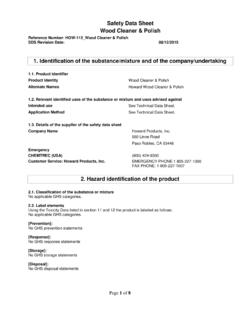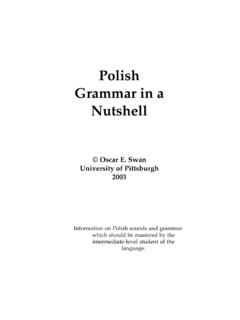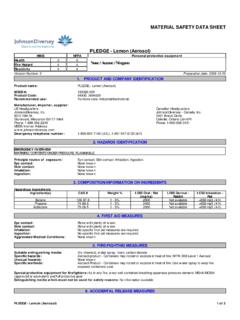Transcription of polish grammar 18mar02 - SEELRC
1 A Concise polish grammar by Ron F. Feldstein SEELRC 2001 1A Concise polish GrammarRonald F. FeldsteinContentsIntroductionChapter 1. polish Sounds and SpellingChapter 2. Major Types of Morphophonemic AlternationsChapter 3. The polish NounChapter 4. polish Adjectival Declension and Comparison. Notes on the 5. The polish NumeralChapter 6. polish PronounsChapter 7. The polish Verb: Conjugation and Notes on Aspect2 AcknowledgementI would like to acknowledge the help of Charles Townsend, of Princeton University, and FrankGladney, of the University of Illinois, who patiently read through earlier versions of this grammar andpointed out many errors and inconsistencies in my exposition. In fact, they provided so many helpful andvaluable suggestions that it would be impossible to offer separate attributions for each instance wheretheir ideas have made their way into the final version.
2 Therefore, I would like to express my gratitude atthe outset and add that I bear the responsibility for any remaining errors that have not been following grammatical sketch of polish , designed for use on the Internet, attempts to covermany of the important points of polish sounds and spelling and morphology, plus selected points in theareas of syntax and usage. It is neither complete nor designed for a sophisticated linguistic than use IPA (International Phonetic Association) or scholarly symbols, standard Polishorthography has been used wherever possible in discussions of the sound system. Nevertheless, I havetried to make all statements accurate, while deviating, in some respects, from traditional school example, the morphological discussion of cases according to Roman Jakobson's morphologicalstudies: nominative, accusative, genitive, locative, dative, instrumental--in preference to the olderordering of nominative, genitive, dative, accusative, instrumental, locative.
3 Jakobson s ideas have alsoinfluenced the presentation of the polish verb, which is based on the notion that the entire verbal paradigmcan be derived from a single stem. Although these Jakobsonian ideas are already found in many scholarlytreatments of polish and other Slavic languages, they are still somewhat rare in presentations designed forgeneral audiences. Thus, this grammatical sketch tries to occupy a middle ground, not attempting to becomprehensive, but aiming at accuracy in its descriptions. While not a substitute for a textbook, it mightprovide a useful review of the sound system and polish us now briefly touch on some of the facts about the polish language of today. polish , ofcourse, is the official state language of the polish Republic (Rzeczpospolita Polska), which, according tothe 1994 census, had a population of slightly under 40 million.
4 The vast majority of the population isethnically polish ( ). Ukrainians constitute slightly more than half of one percent, while other ethnicgroups make up the rest. Many Poles (referred to as Polonia) also reside outside the borders of numbers can be found in the United States, Canada, and Australia, as well as in theneighboring countries of Lithuania, Ukraine, and polish language belongs to the West Slavic branch of the Slavic language family. Other WestSlavic languages are Czech, Slovak, and Upper and Lower Sorbian. The earliest written records of thePolish language date back to the end of the 13th century Earlier polish writing exists, but only in theform of individual polish words within Latin texts.
5 The very important cultural and religious connectionto Latin is related to the fact that Poland, though geographically in Central Europe, is Roman the Orthodox Slavs (Russians, Ukrainians, Serbs, Bulgarians, and Macedonians) use the Cyrillicalphabet of the older Church Slavonic texts, the Roman Catholic Slavs chose the Latin alphabet. The 16thcentury marks the period of the ascendancy of the polish language as a written language in its own uses the Latin alphabet to this day, but since it has many sounds which were lacking in Latin, manyspecial symbols and combinations of symbols have had to be devised to render them. In the realm ofgrammar, polish is marked by a complex inflectional morphology: a large inventory of grammaticalforms and a significant number of stem alternations, conditioned by a wide variety of grammaticalendings.
6 While polish is perhaps the most complex Slavic language in terms of its consonant and vowelalternations, its accentual system is one of the simplest, with a regular stress on the next-to-last syllable ofthe word and no distinction between long and short has had a turbulent history, several times losing and then regaining its national Partitions of 1772, 1793, and 1795 divided Poland among Prussia, Austria, and Russia. Obviously,the polish language played a key role in keeping the idea of a polish nation alive during these periods. In1918, after World War I, Poland was reconstituted as an independent nation, only to lose it and fall underboth German and Soviet occupation during World War II. After a brief period of true independencefollowing World War II, Poland entered the Cold War period of domination by the Soviet Union, duringwhich it languished under Soviet style communism for more than 40 years.
7 The era of Soviet dominationended at the beginning of 1990, when Poland changed its official name from the polish People s Republicto the polish Republic. In 1999, Poland joined the NATO alliance, an act which would have beenunthinkable during its long years of membership in the Soviet-ruled Warsaw 1. polish Sounds and SpellingI. The polish Alphabet and SoundsPolish uses the Latin alphabet, as does English. However, certain letters have a differentsound value in polish , and certain groups of letters are used in ways unknown to English. Inaddition, a series of diacritical marks are used in polish spelling. This is connected with the factthat polish has many more consonants than English and many of the other languages which usethe very same Latin alphabet.
8 The additional symbols allow polish to continue to use the samebasic alphabet as English and many other languages of the world. polish symbols (includingsingle letters and combinations of two letters, known as digraphs) can be divided into those whichrepresent sounds more or less similar to General American English counterparts, and those whichcannot be easily compared to American English sounds. It should be noted that when English sounds are referred to without further qualification, General American English will be understoodas the regional polish letters which represent sounds roughly comparable to those of LetterPolish ExampleEnglish Exampleagazetapotbbokbigccelitsddajdiees ensetffajkafineggazetagotimi amejjestyeskkawaskin s abaswabmma amopnonanapoboklore g ratooppanspansstudentstepttenstemututoo( The polish letters and u represent the same sound.)
9 Wwatavanysynsinzzazoodznodzenods6 When learning the pronounce the above polish sounds, the English speaker must take special carenot to pronounce polish initial p/t/k with the aspiration (puff of air) that automatically occurs after thesesounds in English, at the beginning of a word. In order to approximate the polish sound, the English p/t/kafter s can be used as a better model than initial p/t/k. In other words, the p/t/k of English spot/stem/skinare closer to polish than the same sounds in English pot/Tom/kin. Therefore, if an English speakingperson pronounces such words as pot/Tom in front of a lit match, the flame should be blown out, as aresult of the aspiration.
10 This should not happen with the initial p/t/k/c of polish ( pot/ten/kawa/ca a)or the initial consonants of English spot/ polish consonant sounds that are different from second group of polish symbols (single letters or digraphs) contains sounds which have noclose English counterparts. Therefore, they require more effort and practice on the part of theEnglish-speaking learner. Descriptions of the sounds, together with examples for practice, have beenlisted in the following The dental/alveolar/palatal series of of the most important consonantal features of polish sounds and spelling is the fact that thefour familiar consonants t, d, s, z, each occurs within a series of four consonants. The four seriesare as follows:DentalAlveolarPalatalPalatal BeforeVowel1.






